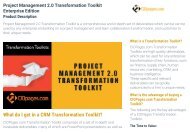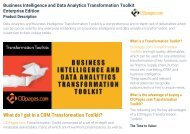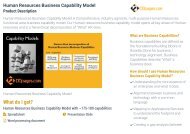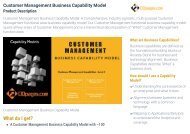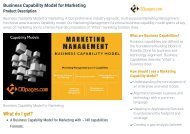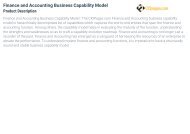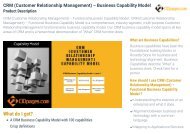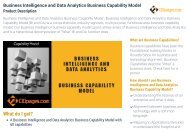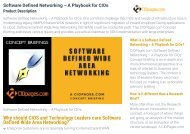Supply Chain Business Capability Model
A Comprehensive, industry-agnostic, multi-purpose Supply Chain Management functional area business capability model. Visit: https://www.ciopages.com/store/supply-chain-management-business-capability-model/
A Comprehensive, industry-agnostic, multi-purpose Supply Chain Management functional area business capability model. Visit: https://www.ciopages.com/store/supply-chain-management-business-capability-model/
Create successful ePaper yourself
Turn your PDF publications into a flip-book with our unique Google optimized e-Paper software.
Formats:<br />
Spreadsheet<br />
Word processing document<br />
Presentation Slide<br />
<strong>Capability</strong> Management in a Box<br />
DETAILS<br />
Looking for more? Try our <strong>Capability</strong> Management in a Box…or<br />
rather in a Spreadsheet<br />
Why do we need a <strong>Supply</strong> <strong>Chain</strong> <strong>Business</strong> <strong>Capability</strong><br />
<strong>Model</strong>?<br />
The value of business capabilities is multi-dimensional as they help bridge the<br />
gap between business and IT, provide transparency into the essence of what a<br />
business does, and align development efforts to strategic priorities, which helps<br />
evolve and enhance capabilities.<br />
Ideally, your firm should have a structured and well-defined enterprise business<br />
capability model, of which <strong>Supply</strong> <strong>Chain</strong> Capabilities should be an integral part.<br />
And furthermore, for the capability model to the actionable, it should be<br />
decomposed to a slightly granular level of capabilities (Level 3 or 4) for it to be<br />
actionable and to leverage in IT enablement projects.<br />
One of the core functions of an enterprise is <strong>Supply</strong> <strong>Chain</strong>. In today’s highly<br />
competitive markets, providing right product/service at the right time, at the<br />
right price, at the right location has become ever more important. And a well-<br />
current state and future state<br />
based on <strong>Capability</strong> maturity<br />
Understanding business needs for<br />
IT enablement based on stable<br />
entities<br />
Conducting vendor analysis using<br />
capabilities to compare apples and<br />
apples<br />
Leveraging in M&A to compare<br />
capabilities and their maturity<br />
between two firms<br />
But, our Company is unique – will it<br />
fit us?<br />
Of course, each company is slightly<br />
different in terms of some capabilities<br />
as well as how they are executed.<br />
However, while there may be<br />
divergence at the edges, there is a lot<br />
of convergence at the core between<br />
most firms. The differences may be<br />
in part due to differences in industry,<br />
geography, types of products and<br />
services, and business model.<br />
Furthermore, the relative emphasis of<br />
the key value streams and absence<br />
or presence of specific capabilities




